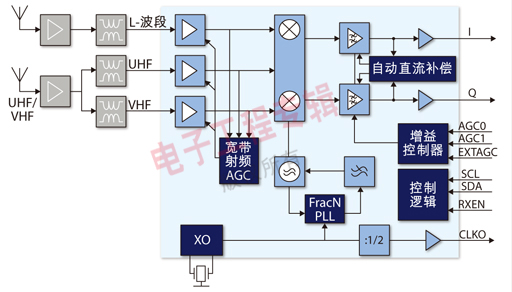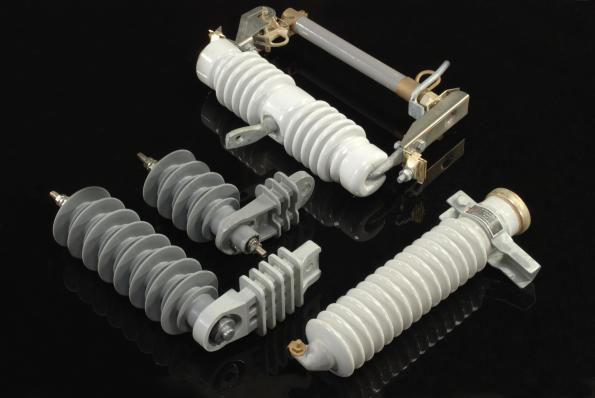A new type of integrated silicon tuner reference design

Figure 1: TUA9001 functional block diagram.
TUA9001 contains most of the necessary RF modules and integrates more than 150 discrete components used in current MOPLL tuners. In the RF tuner using TUA9001, the low noise amplifier (LNA) is external. This external LNA has great flexibility in maximizing sensitivity (low noise figure F) or linearity (adjacent channel ACI performance). When using Infineon's BGA728L7 LNA, system performance requirements will be more easily met. This LNA has low power consumption (1.8V to 3.3V power supply) and excellent noise figure, and its gain can be between "high" (+ 16dB, providing high sensitivity (@ 1.3 dB)) and "low" (-5dB, providing High linearity). TUA9001 and BGA728L7 together can achieve a total noise figure of only about 2.5dB, which is a major breakthrough compared to the MOPLL CAN tuner technology. In addition, BGA728L7 can be turned on and off at the nanosecond level, thereby supporting the time slicing function used in DVB-H.
Infineon can provide users with multiple reference designs based on TUA9001 and supporting multiple digital standards, thus helping to shorten product development time and time to market. The reference design provided by Infineon implements the constraints required by mobile receivers while complying with standards such as MBRAI and Nordic. These reference designs contain network interface modules (NIM) for standards such as DVB-T and CMMB, which use various baseband ICs available on the market. Figure 2 is one of the reference designs for DVB-T.

This reference design is equipped with SMD devices only on one side of the PCB. The entire DVB-T tuner can be installed in an area of ​​2 square centimeters, so that a tuner based on TUA9001 and meeting Nordic standards can be developed CAN NIM has lower BOM cost, smaller footprint and lower power consumption. In the LNA, Infineon ’s low-cost RF transistor BFR380 is used to amplify the RF signal from a single antenna. A duplexer is also used to achieve the division of the two receiving bands of VHF BIII (170 to 240MHz) and UHF (470 to 960MHz), which is only needed in the case of a single antenna (not required if a separate VHF / UHF antenna is used). The performance of the duplexer depends mainly on the required ACI (adjacent channel interference) performance; there are multiple designs that can cover all ACI Nordic cases and provide sufficient margin. The RF signal sent to TUA9001 is further amplified, and the frequency is converted in the I / Q demodulator and then filtered.
TUA9001 has two integrated AGC modules: one is a broadband RF AGC with a built-in detector, it does not require any control or feedback signal from the baseband demodulator; the other is to control the baseband PGF (programmable gain filter) gain Narrow band AGC. The baseband demodulator can control the narrowband AGC through an analog voltage (such as from a filtered PWM signal). In order to achieve faster and interference-free amplitude control, a dedicated AGC bus can also be used for control.
I2C or three-wire bus is used to control IC parameters and set the chip into two different modes: one mode is used to achieve the best IC linearity, and the other is used to achieve the lowest IC power consumption. The specific mode depends on the system requirements. For example, set-top box manufacturers may prefer high-linearity modes, while cellular phone manufacturers prefer low-power modes.
The above reference design uses a crystal with a frequency of 26MHz, the smallest volume and excellent phase noise. The measured phase noise is approximately -100 dBc / Hz @ 1kHz. Its phase noise power is lower than 10mrad, so that SNRp (referred to as the signal-to-noise ratio caused only by phase noise) can reach more than 40dB. It is estimated that this performance is sufficient to meet the requirements of 256QAM-even 1024QAM-OFDM planned in the latest standard DVB-T2. The reference design in Figure 2 can be easily installed directly on the set-top box's PCB board, USB adapter, or any other mobile device. This reference design uses a 4-layer PCB. Since all oscillators are integrated in TUA9001, little or no shielding is required to avoid the various interferences specified by the basic EMC. A reference design that uses a 2-layer PCB for ultra-low-cost applications is currently under development. Compared with the traditional MOPLL IC, the main advantage of this type of DVB-T silicon tuner using TUA9001 is that it requires only half the power consumption (~ 200mW).
There are also DVB-T and DVB-H standards for implementing MBRAI in other reference designs based on TUA9001. Due to the stricter requirements on sensitivity and linearity, these reference designs use the high-performance BGA728L7 (LNA) with a sensitivity of -99dBm. Test results using BGA728L7 show that the sensitivity for CMMB can reach -100dBm. TUA9001 silicon tuner has been widely used in mobile phones and other portable media players. For applications using time-slicing mode, the receiver only works when it receives the required service. The TUA9001 and BGA728L7 or BFR380 in these reference designs have this embedded function. The switching time of TUA9001 and BGA728L7 is less than 1ms, while BFR380 requires about 1.5ms. One advantage of using BGA728L7 is that it reduces the gain when the input signal is very strong, as is the case with ACI. The first test result shows that the LNA can handle input levels greater than 0 dBm in low gain mode. When the gain is switched from low to high, the LNA provides the best performance that RF amplifiers can provide, that is, low noise and high linearity. For devices that strongly require ESD protection at the antenna input, TSLP-4 packaged ESD0P4RFL diodes can be used. The line capacitance of this diode is only 0.4pF, and the air / contact discharge protection voltage is up to ± 15kV, so it is particularly suitable for this application.
In pure digital fixed equipment and most mobile applications, the transition from traditional MOPLL ICs to silicon tuners has already begun. The advantages of smaller size, lower power consumption, high linearity, high sensitivity performance and easy implementation can be realized with TUA9001. Users can now obtain the above reference designs for evaluation and start product development. Silicon tuners are starting a new era of TV receivers.
Cut Out Fuse is a combination of a fuse and a switch, it`s voltage is up to 11kv-33kv, which is made of porcelain, polymer or steel. When the current exceed the specified value, Drop Out Fuse ( Polymer Cut Out Fuse and Porcelain Cut Out Fuse ) will produce heat and disconnect. Arrester is made of porcelain or polymer. The voltage is 11kv-33kv. it is a device used on electrical power systems to protect the insulation and conductors of the system from the damaging effects of lightning.
In electrical distribution, a fuse cutout or cut-out fuse is a combination of a fuse and a switch, used in primary overhead feeder lines and taps to protect distribution transformers from current surges and overloads. we make available these fuses in varied specifications to meet the clients' different preferences in an efficient manner.
China Cut Out Fuse,Polymer Cut Out Fuse supplier & manufacturer, offer low price, high quality Drop Out Fuse, 10 Amp Fuse , etc.
Features
1. Reliable operations2. Rugged construction
3. Longer service life
A lightning arrester is a device used on electrical power systems and tele communications systems to protect the insulation and conductors of the system from the damaging effects of lightning. With these products manufactured as per latest technology standards, these are able to deliver optimum functionality in given application areas.
Features
1.Good hydrophobic nature2.Superior external insulation property
3.Ozone Resistance
4.Good mechanical performance and anti-ageing
5.Assurring best overall protection for transmission and transformation equipment


We warmly welcome friends both domestic and abroad to visit our company, if you have any questions, please contact with us directly.
Cut Out Fuse,Polymer Cut Out Fuse,Drop Out Fuse,10 Amp Fuse
FUZHOU SINGREE IMP.& EXP.CO.,LTD. , https://www.cninsulators.com
